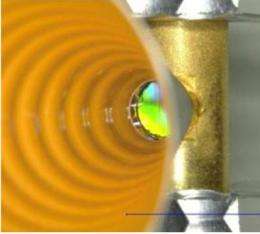Under pressure: Ramp-compression smashes record

In the first university-based planetary science experiment at the National Ignition Facility (NIF), researchers have gradually compressed a diamond sample to a record pressure of 50 megabars (50 million times Earth's atmospheric pressure). By replicating the conditions believed to exist in the cores of several recently discovered "super-Earths" -- extra-solar planets three to 20 times more massive than Earth -- the experiments could provide clues to the formation and structure of these and other giant planets, as well as the exotic behavior of materials at ultrahigh densities.
The team of scientists from University of California, Berkeley; Princeton University; and Lawrence Livermore National Laboratory (LLNL) used, a carefully shaped 20-nanosecond, 750-kilojoules NIF laser pulse within 176 beams to quasi-isentropically compress, or "ramp-compress," multiple thicknesses of diamond to nearly four times the pressure previously achieved in similar experiments by the same team at the University of Rochester's OMEGA laser. Use of the time-dependent ramp-wave compression technique was essential to keep the material relatively cool and solid to higher pressures than could be achieved with standard near-instantaneous shock-physics experiments.
It is the reduced level of heating made possible by ramp compression that makes these experiments relevant to the study of planetary interiors. The standard technique for studying material conditions relevant to planetary interiors is through quasi-static compression in a diamond anvil cell. Those platforms, however, are limited to peak pressures of about three megabars (Mbar), while planetary core pressures range from about 3.5 Mbar (Earth) to about eight Mbar (Neptune), 30Mbar (extra-solar super-Earths), 40 Mbar (Saturn) and 70 Mbar (Jupiter).
"The only way to recreate the interior conditions of large planets is through ramp compression -- and currently, as we've just demonstrated, NIF is the highest pressure platform by some way. In fact we believe we can build on these initial experiments and go to even higher pressures," said the experiment's principal investigator, Ray Smith of LLNL's Physics Division.
As many as 30 percent of main sequence stars are estimated to have planetary companions and more than 500 exoplanets have been discovered to date. Determining the interior structure and composition of exoplanets, while challenging, is key to understanding the diversity and evolution of planetary systems. Planetary surface conditions are closely coupled to interior processes and both have an important influence on the habitability of planetary environments. Unraveling interior structure requires determining the properties of planetary materials under extreme pressure-temperature (P-T) conditions. Accurate determination of the equation of state (EOS) is a fundamental requirement.
Diamond is especially interesting from an astrophysical standpoint because carbon is the fourth most abundant element in the universe and is of central importance in planetary science. Ice giant planets such as Neptune and Uranus contain large quantities of methane that decompose at high pressure and temperature conditions, possibly forming diamond-rich layers in their interiors. A number of extra-solar Neptunes and super-Neptunes have already been discovered, and this class of planet is expected to be quite abundant. In addition, for certain protoplanetary disks with high carbon content, the chemistry of planetary formation may lead to the formation of carbon-rich planets dominated by carbides and diamond.
Smith said shock experiments have made considerable progress in furthering understanding of the phase diagram of diamond in the vicinity of the melting boundary, and the pioneering ramp-loading work at the OMEGA laser has investigated the EOS and strength of diamond at pressures up to eight Mbar.
"The behavior of diamond in the solid state at 10 to 100 megabars, however, is wholly unexplored at present," Smith said. "This represents an exciting opportunity for NIF experiments."
Provided by American Physical Society




















